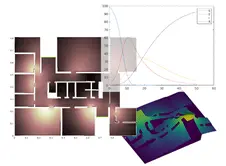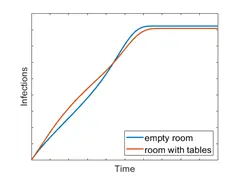Simulation of Pedestrian Flow
How can public spaces be designed to minimize the risk of infection during an epidemic? We discuss this issue with the aid of simulations which are based on a model describing the movement of pedestrians and a coupling with an epidemiological model. This allows the analysis of local epidemiological situations for instance in educational institutions or pedestrian zones.

In a pandemic situation, protective measures are needed that severely restrict social life and the economy. The consequences of the interventions are often difficult to assess and there is a lack of knowledge to determine the optimal level of restrictions.
The question arises whether, for example, business closures can be avoided if the probability of spreading an infectious disease can be reduced by optimal room design. The aim of the project is to develop a software tool that can be used to simulate pedestrian movement and the associated probability of infection with various infectious diseases (Figure 1). The basis is the simulation software pFlow, which calculates the pedestrian flow of evacuation scenarios. pFlow has been developed at the ICP and at the HTWG in the past years [1].

The description of pedestrian flow is now coupled with an epidemiological model in the current project. Typical infection models are so-called SIR models (susceptible, infected, removed) [2].
With the possibility to simulate the spread of infections in a moving crowd, we obtain a novel tool that can be used to deduce design rules for spaces from an epidemiological point of view. This is exemplified with a simple scenario.
We consider a square room with one exit, filled with people who all want to leave the room at the same time. During a pandemic situation, how does the evacuation of an empty room compare to the same room filled with tables? The results of our model are shown in Figure 2.
At the beginning of the evacuation, an empty room is advantageous as the crowd is evenly distributed in the room. The evacuation leads to congestion at the exit. The resulting high densities of people at the exit have a negative impact on the epidemiological situation. Therefore, the number of infections heavily increases at the end of the evacuation.
Comparing the epidemiological situation in the furnished room with its empty counterpart, there is initially a greater increase of infections caused by higher densities of people accumulating between the tables. Yet the furniture has a beneficial impact at the end of the evacuation as people move more slowly between tables. Thus congestion at the exit is less pronounced, resulting in a lower number of infections during the evacuation.
Literature:
[1] R. Axthelm, “Finite Element Simulation of a Macroscopic Model for Pedestrian Flow”, Traffic and Granular Flow ’15, Springer, 2015.
[2] W. Kermack und A. McKendrick, “A contribution to the mathematical theory of epidemics”, Proc. R. Soc. Lond., 1927.